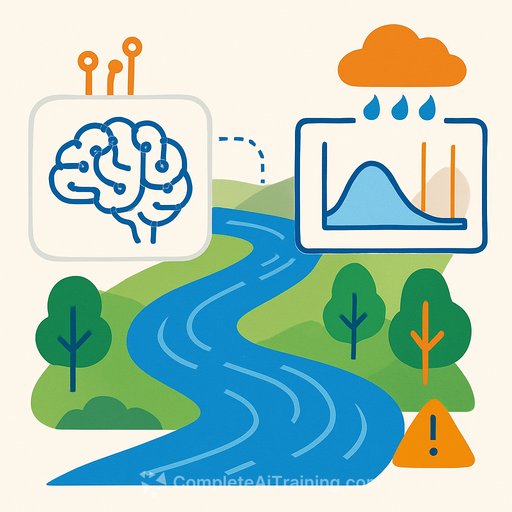Physics-guided AI predicts river flow across the U.S. - with uncertainty you can trust
October 14, 2025
An international team led by Clemson University, with collaborators at Cardiff University and IHE Delft, has built interpretable, physics-guided AI models that predict how rainfall translates into river flow across the entire United States. The models combine deep learning (recurrence and attention/transformers) with watershed physics to deliver daily streamflow simulations and event probabilities. In tests, they outperformed several traditional hydrologic approaches while explaining why a prediction was made.
Why this matters
Stronger floods, longer droughts, and tighter operating margins are stressing water systems. Forecasts that quantify uncertainty and reveal drivers help researchers, utilities, and agencies plan storage, releases, and emergency response with more confidence. Transparent models also speed up adoption because stakeholders can audit what the AI is learning.
What's new
- Physics-guided deep learning: Physical attributes and constraints from watersheds are embedded into modern architectures.
- Probabilistic outputs: The system estimates likelihoods across a range of flow events, not just a single point forecast.
- Interpretability: Clear signals on how rainfall, watershed characteristics, and temporal patterns shape predictions.
- Nation-scale training: Trained on extensive observed and simulated rainfall-runoff data across U.S. basins.
- Performance: Consistently beats several traditional hydrologic models in accuracy while exposing model limitations for further improvement.
How it works (at a glance)
- Sequence modeling with recurrence and attention captures multi-day rainfall-runoff dynamics and memory effects.
- Watershed attributes (e.g., physiography, hydrologic characteristics) provide the physical context that grounds learning.
- Physics-informed design introduces constraints and structure so predictions stay consistent with hydrologic behavior.
- Probabilistic training yields full predictive distributions, supporting risk-aware decisions.
What researchers and practitioners can do with it
- Benchmark against your local or regional models to quantify gains in accuracy and calibration.
- Use predictive distributions to set flow thresholds for flood warning, drought triggers, and reservoir rule curves.
- Stress-test operations by sampling predicted flow scenarios under varying storm sequences.
- Interrogate model explanations to identify data gaps (e.g., gauges, soil moisture) and refine monitoring networks.
- Accelerate model transfer across ungauged or sparsely gauged basins using shared, physics-aware representations.
What stakeholders said
According to the team, embedding physical constraints into modern AI makes daily streamflow prediction more accurate and easier to trust. They highlight two outcomes: quantifying uncertainty around flow events and providing readable explanations of drivers-both critical for adoption by scientists, water managers, and emergency responders.
What's next
- Expand inputs: integrate soil moisture, land-use change, and climate projections to improve skill under non-stationary conditions.
- Co-development: work with water managers, responders, and policymakers to tailor outputs, interfaces, and explanation tools for real decisions.
- Generalization: test transferability beyond the U.S. to diverse hydroclimates.
Paper and resources
- Water Resources Research article: Probabilistic Physics-Guided Deep Neural Networks With Recurrence and Attention Mechanisms for Interpretable Daily Streamflow Simulation
- U.S. streamflow context: USGS Water Data
Skill-building
If you're extending this approach in your lab or utility-feature engineering, uncertainty calibration, and reproducible pipelines matter. For structured upskilling in AI for data analysis, see: AI Certification for Data Analysis.
Your membership also unlocks:






